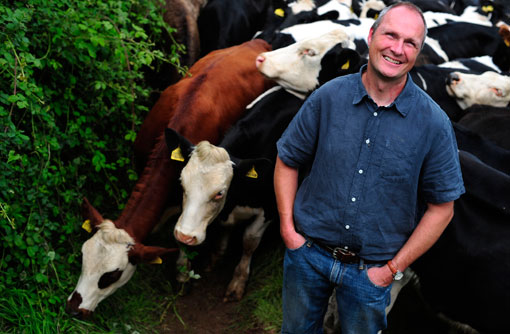FW Awards 2011: Dariy Farmer of the Year finalist – Gavin Fowler

Gavin Fowler
Higher Boode Farm, Braunton, Devon
Ask Gavin Fowler what the key to his success is and there’s no doubt, cross breeding will be high on the list.
The three-way cross-breeding programme at Higher Boode Farm has been pivotal in driving down farm costs by producing a fertile, healthy cow.
The success is clear to see in the unit’s performance figures – profits of more than 6p/litre, along with vet costs of 0.5p/litre, compared to a national average of 1.3p/litre – speak volumes in themselves.
Such results are even more marked considering the farm was functioning at a small loss in 2006 and has remained on the same milk contract throughout. And having farmed a conventional system with Holsteins, the benefits of cross breeding and managing a low-cost system have been particularly striking.
“Rather than changing contract, we decided to look at reducing costs for every litre produced,” explains Gavin.
“Our success has been achieved by a careful breeding programme to produce healthy fertile cows, which are not only easy to keep, but also produce higher-value calves and about 50 surplus pregnant cattle for sale every year.” Such changes are marked considering that eight years ago the farm was buying in cows to keep the herd going,
Achieving a tight nine-week autumn-calving block is key to the success of the system and, consequently, selecting stock for fertility is crucial.
“We use all dairy semen in the first 18 days of breeding and if cows don’t get in-calf in this window, we don’t give them a second chance and serve them to beef. By doing this, all calves are born to first-service mothers and we are breeding fertility into the herd.” Such a strategy has helped achieve an impressive calving interval of 369 days.
Gavin stresses that selecting the correct breed and best-quality bulls is fundamental to the success of cross breeding. His current breeding programme involves a Scandinavian Red crossed onto a Montbelliarde crossed onto a Friesian.
“The Scandinavian Red brings in the high fertility, good feet and low cell counts. The Monbelliardes also have low SCC and high fertility, but also bring in higher yields and the Friesians are chosen for their longevity and hardiness.”
Traditionally, cows were put out to grass in May, but grass was not used efficiently. Now the herd is out at grass from February to the end of October, with paddocks plate metered once or twice a week and cows grazed on 12-hour breaks.
“The farm is suited to autumn calving and the cycle of autumn calving and a quiet summer suits the way we want to farm.”
Environment has always been hugely important in the way the Fowlers farm. The farm is in an ELS scheme and also has 24.6ha in Countryside Stewardship, of which 22.6ha is managed purely for wildlife.
A year ago, Gavin also invested in a pair of wind turbines, which are set to halve the energy costs of the parlour and reduce the farm’s carbon footprint – which is already in the lowest 5% of the Sainsbury’s Cheese Group.
To help fit with NVZ requirements, a slurry separator has recently been installed. A cover on the slurry pit also allows water to be drained down to a series of reed beds, where roof water is also cleaned so it can enter into the surrounding streams.
Gavin is an active council member within MilkLink and a member of the steering group that set up the Sainsbury’s Cheese Development Group within the Co-op.
“Being part of the Milk Link Council and steering group gives me a voice to help influence a small part of the industry,” he says.
The judges liked
Innovative cross-breeding system to suit farm and location
Breeding fertility into the herd
Outstanding profit
Farm facts
280 cross-bred cows
7,500-8,000 litres a cow a year at 4.2% fat and 3.42% protein
Three-way cross to Montbelliarde, Scandinavian Red and Friesian
Low-cost, grass-based system
